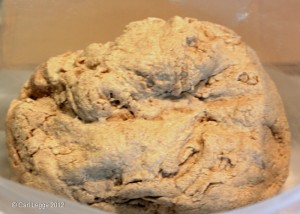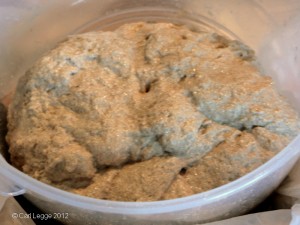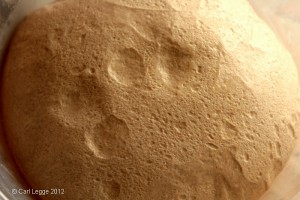
It’s very funny how life works.
I nearly met Anne & Andrew Parry from Felin Ganol Mill last year. We were temporarily in the same room and then I had to leave the next day. That was at an ‘international’ meet up of bakers in Bethesda, North Wales.
Love of bread (and food in general) led me to become online mates with Azelia Torres-Martin. If you look at her blog, you’ll soon find out that Azelia is a bit of a flour geek. Azelia came across the Parrys through her flour researches. She introduced me to them virtually (over t’internet) because she thought we had similar values and ideals about life.
And after a brief email exchange with Anne, I now have a big box of different flours to try from Anne & Andrew’s beautiful mill. That says a lot about their approach to life and to their craft. In exchange for some free flour, they asked for feedback about it from someone who bakes a lot and knows a bit about what they feel & taste. Now I’ve not achieved the levels of geekery that Azelia has, but I do bake quite a bit and enjoy the challenge to learn about new flours.
This is a review of the first flour I tried. It’s milled from a 100% ‘Amaretto’ wheat variety grown by Howard Roberts in Hammonds End Farm, Harpenden. It’s at 70% extraction, which in baker speak means it has only 30% of the wholemeal bits removed. The flour is from the 2011 harvest and has a protein content of 12.3% for those that are into such things.
Leaving some of the bran etc in the flour makes baking a good loaf slightly more difficult. This is because the solid particles break into the strands of protein (gluten) which hold the gas produced by the yeast. So the loaf may not rise as high and the crumb can be dense. I’m sure you’ve had wholemeal ‘bricks’ of bread too. As you can see above, the flour performed very well for me. To find out what I did, please read on…
Amaretto Flour Sourdough Bread Recipe
For my general method for making sourdough see my How to Make Sourdough Bread Simply post and the links in that.
Ingredients
100g of my normal 100% sourdough starter*
500g Amaretto flour
300g warm water
10g fine sea salt
* This is my normal starter I use for everyday. That quantity will have 15g wholemeal rye, 35g Shipton’s No 4 bread flour and 50g water.
This formula gives a loaf which has 63.6% water, which is a little less than I would normally use. I did this because of what Azelia wrote in her post on this flour which is the previous year’s harvest & a lower protein. Of course, I was ready to add more water if needed.
Method
I mixed all the ingredients apart from the salt and 50g of the water. The dough formed easily and felt very soft without being unduly sticky.

After 20 minutes the dough was putty-like and had a small spring back. I added the salt and the remaining water. The dough was then slightly sticky and felt about right to me.

I then folded the dough as shown on the video on this post. I folded four times in total leaving about an hour between each folding session. Also, instead of doing just two folds at each session, I gave it a third fold on the first three goes.
What I feel for when I fold is the resistance of the dough. If the gluten in the dough has developed well, it will be resistant to being folded over a third time. I also look and feel for the change in the dough from a putty-like consistency to being more smooth & elastic with gas bubbles building well.
This dough took a while to develop, so at each fold of the first three sessions I gave it a third fold. I used my ‘gravity method’ for this. I pick up the dough and hang it & give a little shake so it extends and then do one half of the letter fold. I then hang/shake/fold again.
At the end of the folding periods, the dough had clearly developed but still had more to go. It had life, but wasn’t as resilient and extensible as I wanted to see.
So I popped the dough in the fridge overnight. It had about 15 hours in the fridge. I allowed it to warm for an hour, then pre-shaped it and left it for about 30 minutes.

I shaped the dough into a boule and popped it onto some baking parchment. By this time, the dough was strong enough to hold itself up without support.
I baked it at 230°C with a steam tray. It coloured up very quickly indeed so I turned it down to 210°C after 10 minutes. The steam tray came out after 15 minutes in total when the loaf had sprung nicely. I finished off the bake at 190°C for another 35 minutes.
The result
The bread smelt gorgeous as it came out and crackled and sang to me. It has a characteristic ‘torn’ appearance across the middle. The taste of the crust is very special and I had a moist, even and light crumb. The fresh bread tastes very wheaten and it toasts to a gorgeous fragrant crispness.
In conclusion, this is a great flour which produces a great looking and tasting loaf. You need to give it a chance to develop and learn to feel the dough under your hands. I think that’s appropriate: artisan bread made from flour milled by true artisans who care about their product.
Diolch yn fawr Anne & Andrew, I will be back to buy some soon. I’ll write again as I finish my experiements with the other flours.
Other posts you may like:


Comments
2 responses to “Felin Ganol Amaretto Flour: Sourdough Bread”
Very interesting and very good looking loaf Carl! 🙂
Merci Chef 🙂